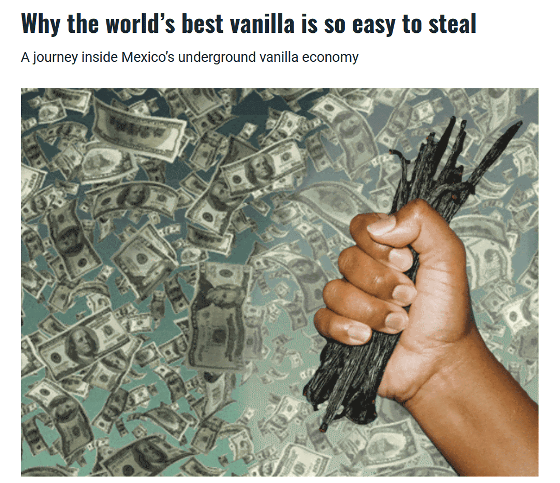Mexican vanilla farmers are plagued by 'vanilla thieves', what is the underground economy surrounding Mexican vanilla?

Why the world's best vanilla is so easy to steal
https://thehustle.co/why-the-worlds-best-vanilla-is-so-easy-to-steal/

Papantura in eastern Mexico is also called 'the birthplace of vanilla', and the Totonac, an indigenous people who lived in this area, have long been regarded as the best vanilla producers. Mexico is lagging behind other countries in terms of vanilla exports in recent years, but there are still many vanilla farmers in Papantura.
67-year-old Jose Cortes, who runs a 15-acre (about 60,000 m 2 ) vanilla farm in Papantura, said that in addition to worrying that the farm would be destroyed by wild animals such as jaguars and birds, ``vanilla theft by criminals.'' He also says that he is suffering from
In fact, Mr. Cortez has encountered armed men while walking in his own forest, and has heard stories of vanilla being stolen from other farmers every year. thing. However, the law enforcement agencies in Veracruz are busy with violent crimes such as murders and kidnappings by drug cartels and gangs, and the Mexican government is unlikely to protect vanilla, which is not a huge industry like avocados and raspberries. It is said that prosecutions are rare.
Therefore, Mr. Cortez and other vanilla farmers may arm themselves and head to the farm to protect themselves and vanilla from thieves. Cortez told The Hustle about how to protect vanilla, 'always carry a shotgun.'

The Totonac have long used vanilla for perfumes, medicines, and sacred ceremonies, and the conquest by the Aztecs and Spaniards brought vanilla's fascination to the outside world. The vanilla commercial market appeared in the 17th century when vanilla caused a sensation in Europe, and the Totonako people began to actively cultivate vanilla.
Vanilla fetches a high price because it grows only in warm tropical regions even in winter, unlike many other crops it grows in small plots mixed with other plants, and it takes a huge amount of time to harvest. is. Pollination must be done manually and within just one day of flowering, requiring vine trimming and proper fertilization. Also, vanilla beans harvested after a year of cultivation must undergo a month of drying work, and none of these processes are mechanized.

In the 1930s, Mexico accounted for half of the world's vanilla exports, but vanilla cultivation in Mexico has declined in recent years, partly because of the emergence of easy-to-export options for North America, such as avocados and raspberries. Masu. The annual export value of Mexico in 2022 is 582,000 dollars (about 84 million yen), which is ranked 35th in the world, which is far behind Madagascar's 619 million dollars (about 90 billion yen). .
However, the actual value of vanilla exports is 10% of the officially reported value, as Mexican vanilla farmers exempt vanilla from taxation by mixing it with other crops and use it as an off-the-books tax-exempt cash source. It is possible that it will double. In fact, Mr. Cortez, who has been cultivating vanilla for generations, produces 440 to 660 pounds (about 200 kg to 300 kg) of vanilla beans every year and earns an annual income of $ 28,000 (about 4.1 million yen). About half of Mexican households have an annual income of $ 7,800 (about 1.13 million yen) or less, so income as a vanilla farmer is essential for local farmers.

With estimates that 80% of vanilla farmers in Mexico have experienced theft, and Gutierrez Zamora, about 30 minutes away from Papantura, up to four vanilla robberies per week have been reported . Theft is a real problem for vanilla farmers.
Juan Salazar, a vanilla farmer and exporter in Papantura, said: 'At night there is no one on the farm. People steal the vanilla and irritate us. It's very hard to take care of vanilla. It could be lost overnight in a robbery.' Although vanilla thieves may be collaborating with organized crime syndicates and corrupt exporters, the perpetrators are believed to be local poor people.
In addition, out of concern that vanilla thieves might steal the vanilla they have grown, farmers harvest vanilla earlier than they should, resulting in lower vanilla quality and lower purchase prices. It is said that there is also a problem.
Still, the people of Mexico do not believe that the vanilla industry will continue to decline, and the Ministry of Agriculture has also announced that if vanilla farmers adopt improved cultivation methods, annual vanilla exports will reach $8 million by 2030. 16 million yen). Politicians in Veracruz are also proposing a mechanism to create a register of producers of vanilla bought and sold in the state so that it can be traced.
'I never stop planting vanilla, it's my culture and my main source of income,' Cortez told The Hustle.

Related Posts:
in Food, Posted by log1h_ik







